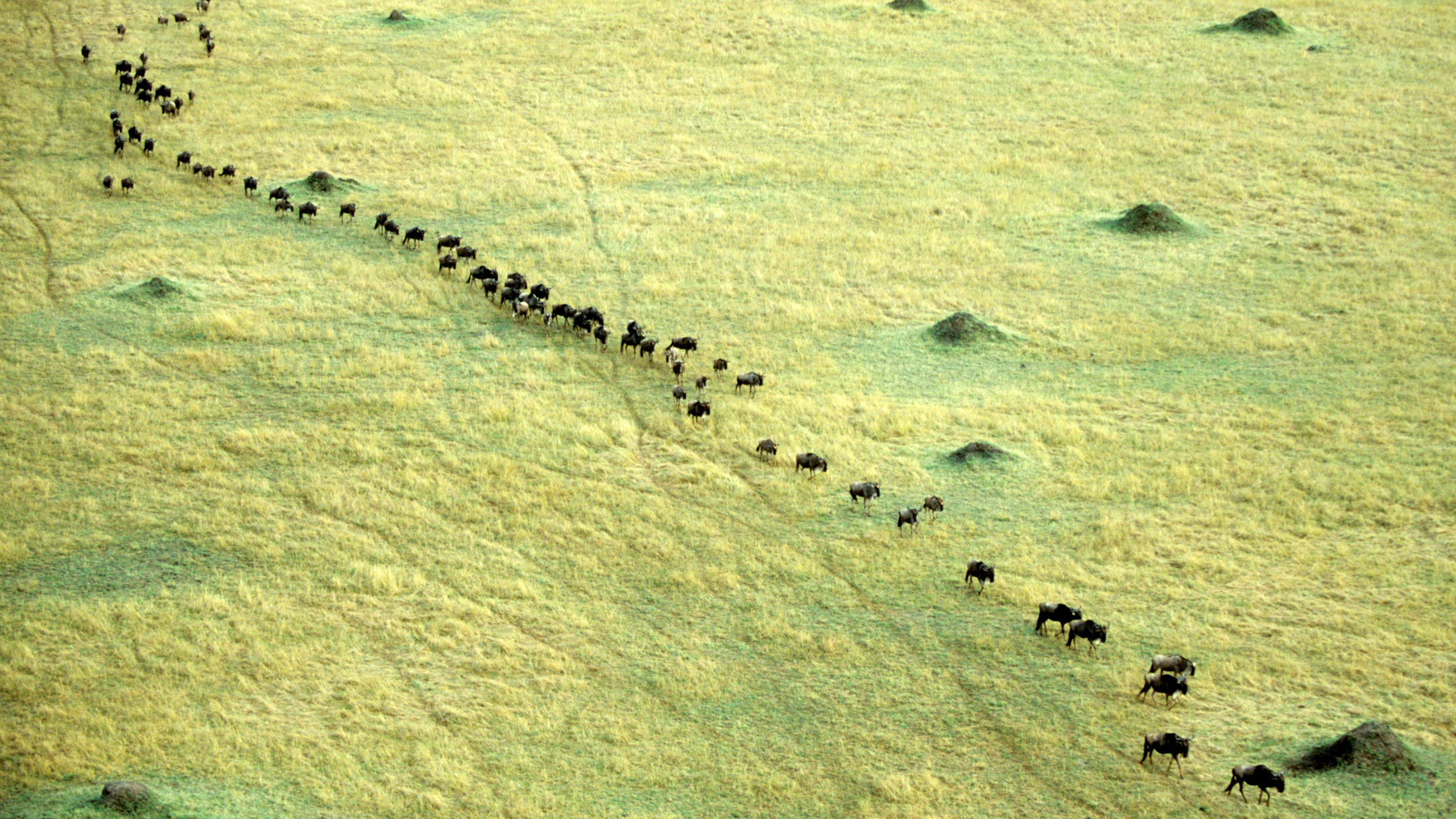The first time I encountered the Great Migration was in a mobile tented camp in the Serengeti. I was awakened by a rumbling, like an earthquake. Outside my tent’s canvas, the wildebeest were moving in long, loose columns, cantering across the earth, the black soil stuck to their hooves. The animals stretched far into the distance, their nodding, bearded heads as ungainly as their galloping gait. Sometimes they skittered left and right, spooked by a predator they knew was lurking somewhere close by. A lion, perhaps, or a pack of hyena that hadn’t had its fill the night before.
I’ve always tried to avoid the crowds on my travels, but East Africa’s wildebeest migration is one mass event that draws me back again and again—an iconic phenomenon that sees 1.5 million wildebeest sweep through Kenya and Tanzania on an annual, 1,200-mile cycle. In Kenya, the wildebeest pass through the Mara; in Tanzania, they move through the Serengeti—two contiguous protected areas where they graze and calve. They’re in pursuit of the seasonal swings bringing new grass and water. In the wings of their advance are zebra, which also move with the new shoots of grass. In their wake come the predators: lion, cheetah, circling vultures, and at the river crossings, a frothing stew of crocodiles, who pick off the exhausted ones. The challenge is working out where and when you can catch the best of this spectacle, while avoiding the human densities that also wait in ambush with their cameras.
Where to Stay—and What Guides to Book
The Mara is only a quarter of the entire Mara-Serengeti ecosystem, but it’s the most iconic part—largely because of the movie, Out of Africa, which catapulted Kenya’s reputation out of political crises to reframe it as the most romantic territory on earth. From the cliffs of Angama Mara, and the rocky kopjes featured on the movie’s poster, you look out over the Kenyan savannah, which, from July to October, is peppered black with the herds. The 15-suite Angama Marais relatively new, luxurious, and close to the Mara River, which crosses the border between Kenya and Tanzania. It’s a good lodge to access the herds’ river crossings. For an even closer encounter, stay in Angama Mara’s high-luxe equivalent on the Tanzanian side, the Singita Lamai - Mara River Tented Camp, which is built above an oxbow. This causes the herds to bottleneck, creating even more drama for the browsing crocs, which you can catch from your riverbank bathtub.
For some, however, the gory killing grounds of the rivers are too much to take (the aftermath in November and December isn’t great either, when the stench of rotting, bloated carcasses move downstream to catch in the riverbanks). I prefer the calm calving grounds of the southern Serengeti plains, from January to March. Life and death are still present—an awkward newborn struggling to its feet, watched by a pride of lion waiting to feed—but somehow it feels more optimistic out here, in those wide-open short-grass plains where the clouds seem to skim the earth. A staggering 8,000 wildebeest are born each day, replenishing herd numbers for another year.
For this territory, I’d recommend a seasonal camp specifically located to catch the best of the calving season: Serian’s Serengeti South is a classic tented old-school safari camp presided over by one of Africa’s most sought-after walking guides, Alex Walker. For a fixed camp with all the trimmings, Mwiba Lodge, also in the southern reaches of the Serengeti, cuts a seriously luxe edge: Mwiba has the best beds of any lodge I’ve experienced in Africa, with drifts of air-conditioning floating in a cooling stream over the canopy. Mwiba also stands out for its impeccable masseurs, food, and service.
The idea of movement is built into the concept of migration, and for that reason, advancing with the herds is the most exciting trip of all—a genuinely lightweight mobile outfit, which means the camp is set and struck every few days; along with hot, ensuite showers, a mobile kitchen for delicious salads and grilled campfire meats, with each Hemingway-style expedition commanded by a walking guide who gets you close to the action. Given notice—and booking at least two years in advance due to demand—I’d recommend Richard Knocker at Nomad Tanzania. For Kenya: the man Ralph Lauren uses is Peter Silvester at Royal African Safaris, a weathered Kenyan who can regale the campfire with charm as well as navigate the Mara blindfolded. For all bookings, including a mix of migration camps with a beach to wash off that safari dust, I’d recommend Kenya-born Will Jones at Journeys by Design.

